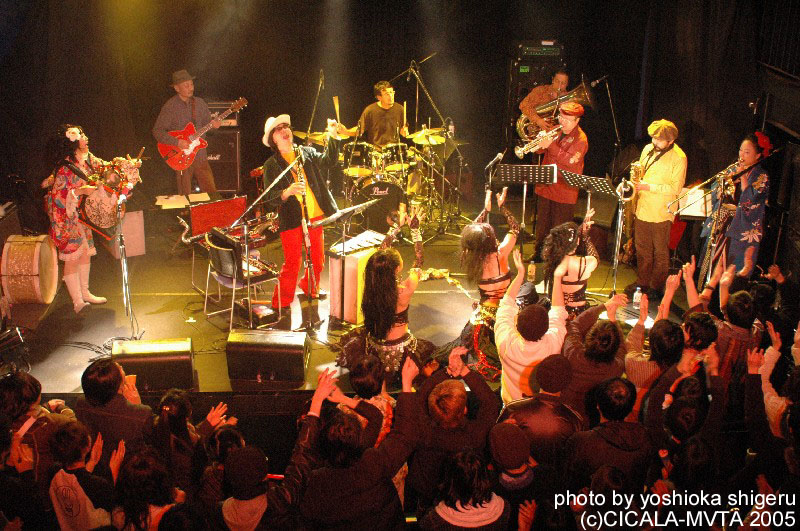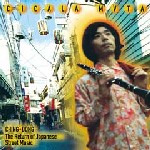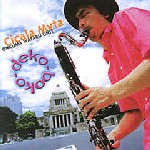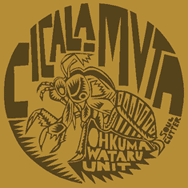profiles
WHAT IS CICALA-MVTA ?
Hailing from Tokyo, Japan, Cicala-Mvta (pronounced shikala moota) is a RIO/Avant-Prog band formed in 1994 by multi-instrumentalist Wataru Okuma (clarinet, bass clarinet, vocals), featuring Yoshiyuki Kawaguchi (saxophone), Yoshiki Sakurai (guitar), Takero Sakijima (tuba, recorder), Tatsuya Yoshida(drums, vocals), Keisuke Ota (violin, vocals), Yoshiaki Sato (accordion), Yoichiro Kita (trumpet), Akiko Watanabe (trombone) and Miwazo Kogure (ching-dong, gorosu).
Extremely versatile and omnivorous, Cicala Mvta integrates Japanese Chindon (street music) with Klezmer, Jazz, folk, punk, noise and traditional music from the world over.
The band name Cicala Mvta (mute cicada in Italian) is taken from an epitaph for the most famous Japanese street singer/songwriter from the 1920s, Soeda Azembo; “mute cicada” is an ironic expression for the sharp, loud, and poignant social satire Soeda offered through his songs.
REVIEWS
 Cicala-Mvta is One of Japanese Most Exciting and Original Groups. Both Traditional Chindon and the Retro-futuristic Sound of Cicala-Mvta is an Entirely Natural Combination of the Old and New, the East with the West. (Amazon review)
Cicala-Mvta is One of Japanese Most Exciting and Original Groups. Both Traditional Chindon and the Retro-futuristic Sound of Cicala-Mvta is an Entirely Natural Combination of the Old and New, the East with the West. (Amazon review)
Cicala Mvta is a group described by some UK music critics as the most impressive exponents of contemporary Japanese grass roots music. The music presents old-fashioned and brass band music. Featuring chindon, a kind of Japanese drum, saxophones, clarinets and tubas, Cicala Mvta's music is a kind of street music originally played at funerals or the openings of local shops. But the band blends the cheesy music with social critique, thus creating a sarcastic outlook, in both its musical style and in its stage performance. (TAIPEI TIMES By Yu Sen-lun Jun 18, 2004)
Before TV commercials, drum and woodwind bands would march through the streets of Japan carrying banners advertising products or stores. Bandleader WATARU OKHUMA modelled his band after these Chindon groups and named it CICALA-MVTA .(Pronounced Shi-ka-la Moo-ta, it means Mute cicada after the epitaph of a great Japanese street singer songwriter) All in all, it is a wild ride, as Cicala Mvta views klezmer, Balkan, Turkish, early jazz and free jazz music through their Japanese street band lens, which has something to do with topology and physics and their bent view of musical reality. (Radio National ;Australia)
THE NAME OF THE BAND
It derives from the inscription on the epitaph of Soeda Azembo(1872〜1944) ; a legendary street singer.
“ A CICALA-MVTA CHE CANTAVA E LA SVA MOGLIE CHE L' AMAVA ”
(The mute cicada that sang and his wife who loved him)
This is from the epitaph for Soeda Azembo (mute cicada) the greatest street singer-song-writer of popular music in Japan, before the 1920's --- the beginning of the days of mass culture. In those days the street-singers used to sing and sell the songbook on the street. And the incredible point is that before radio broadcast and SP records, his comical and sarcastic songs often became a mega-hit in the whole country. Also he is known to create the first modern protest song in the movement of the early socialists in Japan. His pen-name derives from the ironic humor that the "mute cicada" loudly sang ! But it was not humorous , that after the mid1920's, the hard oppression of the militant totalitarism and the development of mass culture industry got him really mute.
WHAT IS "JINTA" ?
The first western music formally imported into Japan was brassband-music as a part of military technology, like in many other colonized countries. The military brassbands not only played marching music but also western classics, to demonstrate the western music to the people. At first it was entirely a high-culture.thing. But it didn't take a long time to find it's cheap imitators. Most of those commercial bands were recognized in official to be vulgar or kitsch , but lots of them became be popular in downtown Tokyo. People intimately called those bands "Jinta" , one of the predecessors of chin-don.
<SHORT HISTORY>
1960 OHKUMA Wataru born in HIROSHIMA pref.
1979 He started music career in an avan-garde rock band in TOKYO
1985 He met CHIN-DONG tradition and started clarinet
1994 He organised his own band later named CICALA-MVTA
1998 CICALA-MVTA released their 1st album”CICALA-MVTA”
2000 The 1st Euro tour around 8 countries more than 20 cities
including at ROYAL FESTIVAL HALL (London with BLUR),BBC radio recording,etc.
2001 The 2nd album “DEKOBOKO” was released
2002 The 2nd Euro tour including Roskilde festival(Denmark), Roots festival (Holland),etc.
2003 appeard at FUJI ROCK FESTIVAL (japan)
2004 released the 3rd album “GHOST CIRCUS”
petit-CICALA-MVTA appeard at THE ASIAN MUSIC FESTIVAL (Taiwan Chiayi)
<ALBUM REVIEWS>
The Return of Japanese Street Music in a different way with CICALA-MVTA
(The review for the 1st album 1997/ text by Paul Fisher)
 The band Cicala Mvta was founded in 1994 by its leader Wataru Ohkuma who is rated as one of the most innovative musicians of contemporary Japanese music. He is a superb player of the clarinet, saxes, vibes and accordeon.
The band Cicala Mvta was founded in 1994 by its leader Wataru Ohkuma who is rated as one of the most innovative musicians of contemporary Japanese music. He is a superb player of the clarinet, saxes, vibes and accordeon.
As producer and bandleader Wataru Ohkuma had participated in many revolutionary recordings of the 80ties (a.o. "Soulflower Mononoke Summit") .
Wataru Ohkuma merges in his music Okinawa-style music and other traditional Japanese forms like Jinta with western composition techniques and traditions.
Some say this CD "Ching Dong" is the Japanese answer to Giora Feidman and to Fanfare Ciocarlia. The bands name, Cicala Mvta is Italian and is written as the epitaph on the gravestone of the greatest street singer songwriter of popular music in Japan before the 1920s,Soeda Azembo, who at the time around 70 years ago, unable to speak his mind in fear of being thrown into prison, like having a cicala stuck in his throat, a "mute cicada".
The band Cicala Mvta merges Japanese Chindon music with own compositions and traditional music from various ethnic regions. Ohkuma plays a composition by Paul Dessau as well as Kabuki-melodies (Shi-chome) and Nepalese wedding dances or Klezmer songs.
Basis is Chindon music which until 50 years ago was a popular street form of advertising. Chindon bands were common in Japanese cities where new openings of shops, inaugurations of Pachinko's a.o. were announced by them.
In Cicala Mvta brass bands from Balkan meet Klezmerbands as well as New Orleans Marching Bands within the overcrowded streets of Tokyo.
The British magazine "FolkRoots" about "Ching Dong":
“The stirring debut album by Cicala Mvta, Wataru Ohkuma's own band, produces complex, challenging and powerful music.”
DEKOBOKO (2nd album 2001)
 Japanese 7 piece with wild street band material, much of it folk influenced (Japanese, East European and other) with additive rhythms and an approach that moves from the legendary Compostella to the big unison melody statements of Ground Zero. Great There's a fine Albert Ayler medley and a piece based on Bartok's microcosmos too. The energy peaks at Ornette Coleman levels and the performances and arrangements are sure, clear and impressive. Straight ahead musical. (ReR megacope;England)
Japanese 7 piece with wild street band material, much of it folk influenced (Japanese, East European and other) with additive rhythms and an approach that moves from the legendary Compostella to the big unison melody statements of Ground Zero. Great There's a fine Albert Ayler medley and a piece based on Bartok's microcosmos too. The energy peaks at Ornette Coleman levels and the performances and arrangements are sure, clear and impressive. Straight ahead musical. (ReR megacope;England)
Before TV commercials, drum and woodwind bands would march through the streets of Japan carrying banners advertising products or stores. Bandleader WATARU OKHUMA modelled his band after these Chindon groups and named it CICALA MVTA・(Pronounced Shi-kah-lah Mooh・tah, it means Mute cicada after the epitaph of a great Japanese street singer songwriter. All in all, it is a wild ride, as Cicala Mvta views klezmer, Balkan, Turkish, early jazz and free jazz music through their Japanese street band lens. The album is called DEKO-BOKO, which has something to do with topology and physics and their bent view of musical reality. (Radio National;Australia)
Cicala Mvta Are One of Japan's Most Exciting and Original Groups. The Mixtures on 'deko Boko' Are More Radical Than Ever and the Tunes were Penned by Ohkuma and Arranged by the Group. Both Traditional Chindon and the Retro-futuristic Sound of Cicala Mvta Are an Entirely Natural Combination of the Old and New, the East with the West. (Amazon review)
GHOST CIRCUS (3rd album 2004)
 Wild and raucous, but completely under control, big-band style, street orchestra style, mixed up kids: clarinet family, saxes, violin, cello, lap steel guitar, autoharp, bass, drums, musical saw, tuba, electronics... Fine arrangements, often at breakneck speed, exquisitely recorded with a Sogenanntes Linksradikales Blasorchester political edge (El Puebro Unido & Jara's Right to Live in Peace). You know after 2 bars it's Japanese - that hyper-real energy, technical skill, overall perfection and plain human force just shine through. (ReR megacope)
Wild and raucous, but completely under control, big-band style, street orchestra style, mixed up kids: clarinet family, saxes, violin, cello, lap steel guitar, autoharp, bass, drums, musical saw, tuba, electronics... Fine arrangements, often at breakneck speed, exquisitely recorded with a Sogenanntes Linksradikales Blasorchester political edge (El Puebro Unido & Jara's Right to Live in Peace). You know after 2 bars it's Japanese - that hyper-real energy, technical skill, overall perfection and plain human force just shine through. (ReR megacope)
Third album from Cicala Mvta is up to their usual high standard of creative, unclassifiable, amalgamation of individual spirits, who collectively are an exploding melting pot of sound. With circus and street band music at the core, their instrumental music on clarinet, sax, violin, electric guitar, tuba, cello and drums is constantly shifting in mood, surprising and as always with Cicala Mvta, compellingly briliant. (farsidemusic;England)

